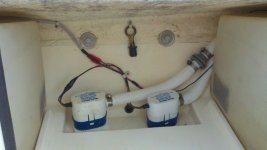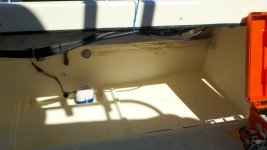Recently while I had the tanks out for cleanup and to do the swim step, I took the time to install a second bilge pump. I didn't want to use any more through hulls, and I don't use the port lazarette as an fish/ice box. So I removed the lazarette to through hull hose and used the through hull for the second pump.
I bought about 4 feet of the bilge hose, 4 stainless hose clamps, a one-way valve, 4 feet each of 16AWG black and red wire, and a waterproof inline fuse holder (5A fuse). I had a spare RuleMate 1100 and a piece of 3/4" starboard.
I cut the starboard down to roughly match the pump footprint, and screwed the basket to the starboard (using stainless screws and pilot holes). I drilled some 1/4" holes in the bottom of the starboard block and buttered some 4200 on it, working some into the holes. I stuck it down on the bilge floor and left it for about 2 hours before hooking anything up.
I wired the pump to the starter battery with the fuse near the positive terminal. The primary pump (existing) is wired to the other battery. The manual override wire (brown with white stripe) isn't used.
The idea for using the starboard block is that the back up pump will only come on if the primary pump has failed, or if there is enough water to activate both. Though the pump isn't connected to the helm switch, it can easily be tested by removing it from the basket and turning it over (the magnetic float switch will turn it on).

I bought about 4 feet of the bilge hose, 4 stainless hose clamps, a one-way valve, 4 feet each of 16AWG black and red wire, and a waterproof inline fuse holder (5A fuse). I had a spare RuleMate 1100 and a piece of 3/4" starboard.
I cut the starboard down to roughly match the pump footprint, and screwed the basket to the starboard (using stainless screws and pilot holes). I drilled some 1/4" holes in the bottom of the starboard block and buttered some 4200 on it, working some into the holes. I stuck it down on the bilge floor and left it for about 2 hours before hooking anything up.
I wired the pump to the starter battery with the fuse near the positive terminal. The primary pump (existing) is wired to the other battery. The manual override wire (brown with white stripe) isn't used.
The idea for using the starboard block is that the back up pump will only come on if the primary pump has failed, or if there is enough water to activate both. Though the pump isn't connected to the helm switch, it can easily be tested by removing it from the basket and turning it over (the magnetic float switch will turn it on).



